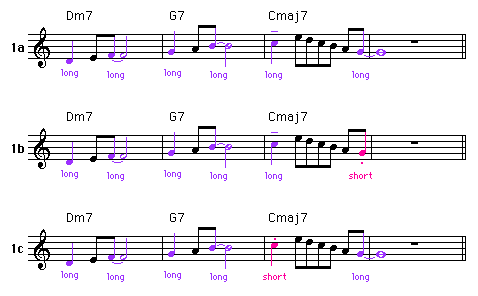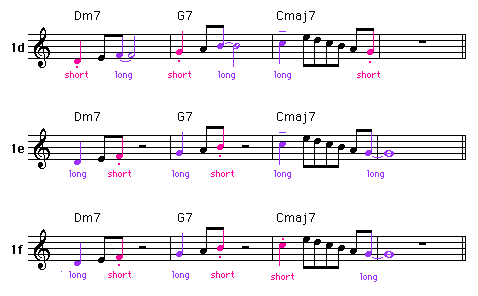In the broader context of the whole melody (or improvisation)
this may be a perfectly good phrase. However taken on its own it
lacks a degree of excitement and energy.
Why ?
There is no
variation in articulation.
All notes of the 4
bar phrase are articulated in smooth legato.
Audio 16.6

By simply altering the articulation of a single note into a
short aggressive staccato
(like in 1b and 1c below) the whole phrase takes
on a new life.
Audio 16.7

You can vary the articulation anywhere in a phrase, but the
beginning and end of a phrase or a phrase segment are especially
good places to do this. Below some examples (1d,
1e, 1f).
Audio 16.8

Note that the articulation of each repeated 2nd bar is in each
case the same as the articulation in the 1st bar.
The
articulation in the last phrase segment (bars 3 and 4) is
different however, providing extra contrast between the 'calls'
and the 'response'. |
Experiment with various articulations in your improvisations and
also on IIm7-V7-Imaj7
phrases.
(Down - Up -
Top - Links)
S 16.4 - Articulation P-a-L
Exercise
Play-a-Long track jf16st1 (of swapping
twos) consists entirely of a succession of 4 bar long
progressions of :
Dm7 (1 bar) -
G7 (1 bar) - Cmaj7 (2 bars)
- Each odd numbered 4 bar phrase : I play the first 2
bars, you play the second 2 bars with complementing or
contrasting articulation.
- Each following even numbered 4 bar phrase is a repeat
of the previous 4 bars.
A second Play-a-Long jf16st2 (of
swapping fours) is the same as the first track, but :
- Each odd numbered 4 bar phrase : I play the complete
4-bar phrase.
- Each following even numbered 4 bar phrase is left
blank for you to repeat the previous 4 bar phrase or play
your own phrase.
The main objective is to create interest through your
articulation.
You can use track jf16st2 also as an
alternative exercise on starting and
ending notes.
In the Table below each number indicates the chord tone (1 =
root, 3 = 3rd, etc.) used as my starting and ending note for each
phrase on track jf16st2.
The
corresponding Concert key notes are shown in black.
The corresponding Bb instruments notes
are shown in red.
The corresponding Eb instruments notes
are shown in blue.
| Phrase No. | Starting note (of Dm7) | | Ending note (of Cmaj7) |
|---|
| Phrase 1
| 1 = D -- E -- B |
| 3 = E -- F# -- C#
|
| Phrase 3
| 1 = D -- E -- B |
| 7 = B -- C# -- G#
|
| Phrase 5
| 1 = D -- E -- B |
| 3 = E -- F# -- C#
|
| Phrase 7
| 3 = F -- G -- D |
| 3 = E -- F# -- C# |
| Phrase 9
| 3 = F -- G -- D |
| 5 = G -- A -- E |
| Phrase 11
| 3 = F -- G -- D |
| 3 = E -- F# -- C# |
| Phrase 13
| 3 = F -- G -- D |
| 7 = B -- C# -- G#
|
| Phrase 15
| 5 = A -- B -- F# |
| 5 = G -- A -- E |
| Phrase 17
| 5 = A -- B -- F# |
| 5 = G -- A -- E |
| Phrase 19
| 5 = A -- B -- F# |
| 3 = E -- F# -- C# |
| Phrase 21
| 5 = A -- B -- F# |
| 7 = B -- C# -- G#
|
| Phrase 23
| 7 = C -- D -- A |
| 7 = B -- C# -- G#
|
| Phrase 25
| 7 = C -- D -- A |
| 9 = D -- E -- B
|
| Phrase 27
| 7 = C -- D -- A |
| 3 = E -- F# -- C# |
| Phrase 29
| 9 = E -- F# -- C# |
| 5 = G -- A -- E |
| Phrase 31
| 9 = E -- F# -- C# |
| 5 = G -- A -- E |